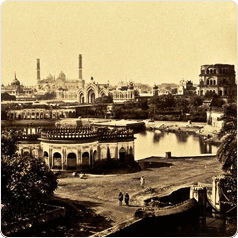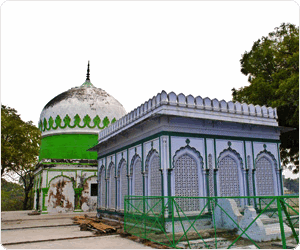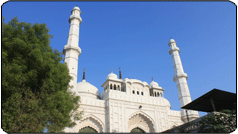
Tila Shah Pir Mohammed
There are two very old tombs of the Moghul period in Lucknow. One is the Chahar Khamba (four pillared) tomb which has a marble grave covered with a canopy of red stone with brackets on four slender stone pillars, which are handsomely fashioned. Situated in a lane behind the Nadan Mahal tombs in the old city, it is a protected monument in the list of the Archaeological Survey of India (A.S.I.). The person buried in the grave is unknown, but the tomb appears to belong to the Moghul Emperor Akbar's period on account of its architectural features. It is believed to have been built around the same time as the Nadan Mahal (mausoleum of Sheikh Abdur Rahim) and Solah Khamba (sixteen pillared) pavilion adjoining it.
People believe the grave to belong to some martyr (shaheed) and regularly pay respects to him by lighting a lamp on Thursday evening and offering flowers. An annua! urs to commemorate the death anniversary of the martyred saint is also held there by the residents of the nearby localities.
The other tomb or mausoleum (maqbara) is that of Shah Pir Mohammed adjoining the Pucca Pul (Stone Bridge), on the Bara imambara side, next to a mosque called Tilewali masjid.

Shah Pir Mohammed arrived in Lucknow during the reign of Aurangzeb when it was under the Moghul rule. He was born at Itawan, a village in Jaunpur district in the month of Ramzan of 1027 Hijri (1619 AD). He studied at Manikpur and was the disciple and follower of Sheikh Abdullah Chishti, Sayyah Dakhni. He studied under Allama Haider at Delhi and was also a student under Qari Abdul Qadir Umri at Lucknow.
He did not marry and spent his whole life in the study of religious doctrines and scriptures and guided students who came to his abode, for the interpretation of theological matters. He also authored a number of religious treatises. Shah Pir Mohammed died at Lucknow on 13th of Jamadi-us-sani, 1083 Hijri (1673-74) and was buried at his abode.
Abdul Halim Sharar, the famous author of Guzishta Lakhnau and the translators of his book to English, E.S.Harcourt and Fakhir Hussain in their notes have erroneously mentioned Shah Pir Mohammed and Shah Mina as the same person (they have their separate places of burial).
The square mausoleum of Shah Pir Mohammed is dominated by a large dome resting on a tall cylindrical drum. The dome and drum are nearly twice the height of the three arched square compartment at the base. Besides the grave of Shah Pir Mohammed inside the small hall, there are two graves, at the entrance towards south and on the platform outside. One of them, towards west, has extremely intricate and beautiful inlay work on its marble surface, eventhough the coloured stones studded therein have disappeared.

There is another hall, later built, adjacent to the main mausoleum, which also has a number of graves, probably belonging to the later followers and disciples of Shah Pir Mohammed.
The mound near the mausoleum and nearby mosque is said to have been formed when the eastern gateway of the Bara Imambara of Asaf-ud-Daulah (which was parallel to and corresponded with the Rumi Darwaza on the west) was bombarded and demolished by the British in July 1857. The mound was also used in 1857-58 for setting up scaffolds to hang the rebels (freedom fighters) who had revolted against the unlawfully imposed British rule. Name of at least five freedom fighters and heroes hanged are available in historical accounts as Maulvi Rasool Bakhsh, Hafiz Abdul Samad, Mir Abbas, Mir Qasim Ali Kamadan and Mammu Khan. Unfortunately they still remain unhonoured by our people and Government sans any memorial at the site.
Hindustan Times, A Time in History
Wednesday 4.8.1999 — Tombs of unsung heroes

